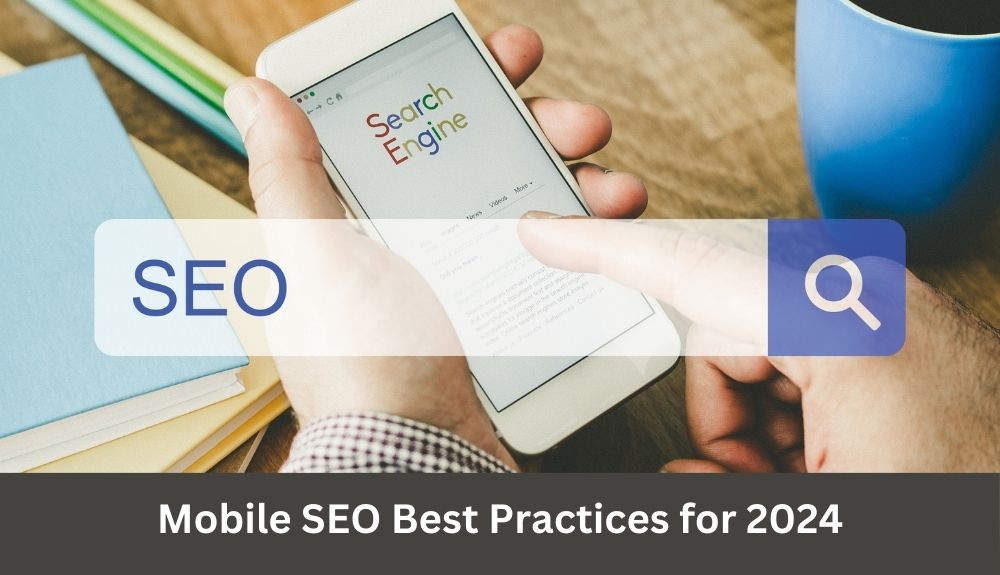Are you ready to stay ahead of the game in the dynamic world of digital marketing? In 2024, mobile SEO is more vital than ever before. With the majority of users accessing the internet through their mobile devices, optimizing your website for mobile is crucial for driving organic traffic, improving user experience, and ultimately achieving better rankings on search engines.
In this comprehensive guide, we will dive deep into the realm of mobile SEO and equip you with the knowledge and strategies needed to be mobile-first in 2024. From effective mobile SEO practices and the importance of responsive design to tips on optimizing titles, meta descriptions, and images for mobile devices, we have got you covered. We’ll also explore the significance of mobile-first indexing and voice search, as well as guidance on enhancing content accessibility, implementing structured data, and optimizing video content for mobile SEO.
Get ready to unleash the power of mobile SEO and take your digital presence to new heights. Let’s dive in and master the ever-changing landscape of mobile SEO together.
Introduction to Mobile SEO
In 2024, mobile SEO continues to play a crucial role in the digital marketing landscape. With the increasing use of mobile devices, optimizing websites for mobile has become more important than ever. Mobile SEO focuses on improving the visibility and user experience of a website on mobile search engines.
The impact of mobile SEO on search rankings and user experience cannot be underestimated. Search engines like Google prioritize mobile-friendly websites in their search results, ensuring that users are directed to a website that provides a seamless mobile experience. Additionally, a well-optimized mobile website reduces bounce rates and increases engagement, leading to higher conversion rates.
In this fast-paced and mobile-driven era, businesses need to adapt their SEO strategies to cater to the majority of users who rely on mobile devices. Ignoring mobile SEO can result in missed opportunities and lower organic traffic.
By implementing effective mobile SEO strategies, businesses can ensure their websites are easily accessible, user-friendly, and optimized for mobile search engines. In the following sections, we will delve deeper into the best practices and strategies that will help you stay ahead in the realm of mobile SEO in 2024.
Remember, mobile SEO goes beyond having a responsive design. It encompasses various factors such as mobile site speed, structured data implementation, content accessibility, and optimizing for voice search. By focusing on these aspects, businesses can provide a wholesome understanding of mobile site optimization and improve their overall mobile user experience.
Stay tuned to discover the latest mobile SEO trends and strategies that will drive organic traffic and elevate your digital marketing success in 2024.
Main Points:
– Mobile SEO is crucial in 2024.
– Optimized mobile websites improve search rankings and user experience.
– Mobile SEO involves more than just responsive design.
– Key factors include mobile site speed, structured data, and voice search optimization.
– Upcoming sections will explore best practices and strategies for mobile SEO.
What is Mobile SEO?
Mobile SEO refers to the practice of optimizing websites and content specifically for mobile devices to improve search rankings and enhance user experience. It involves tailoring your website to meet the unique requirements and preferences of mobile users, who now constitute a significant portion of online traffic.
Why Mobile SEO Matters
In today’s digital landscape, mobile devices have become the primary means of accessing the internet. With the increasing popularity of smartphones and tablets, catering to mobile users has become essential for businesses looking to stay competitive and reach their target audience effectively.
When compared to traditional SEO, mobile SEO takes into account the distinct characteristics of mobile devices, such as smaller screens, touch-based navigation, and varying connection speeds. Websites that aren’t optimized for mobile may suffer from slow loading times, difficult navigation, and ultimately, poor user experience.
The Significance of Mobile-Friendly Websites
A mobile-friendly website ensures that users can access and navigate your site easily on smaller screens. It involves adopting responsive design principles, which automatically adjust the layout and content to fit different screen sizes. A mobile-friendly website enhances user experience, reduces bounce rates, and improves the chances of converting visitors into customers.
Differences Between Mobile SEO and Traditional SEO
While there are similarities between mobile SEO and traditional SEO, they differ in terms of focus and optimization. Mobile SEO places more emphasis on factors such as mobile site speed, responsive design, user-friendly experience, and optimizing for local searches. On the other hand, traditional SEO primarily focuses on desktop search optimization.
Mobile SEO considers the specific needs and behaviors of mobile users, recognizing their preferences for quick access to information and location-based results. This requires optimizing titles, meta descriptions, and images specifically for mobile search results. It also involves implementing structured data markup to enhance the visibility and relevance of your content to search engine bots.
The Benefits of Mobile SEO for Businesses
Implementing effective mobile SEO strategies can yield several positive outcomes for businesses. Firstly, it improves search rankings, increasing visibility and driving organic traffic to your website. Additionally, a mobile-optimized site improves user experience, reducing bounce rates and encouraging longer engagement.
By prioritizing mobile SEO, businesses can gain a competitive advantage in the realm of mobile search. With the majority of organic search visits now coming from mobile devices, ensuring a wholesome understanding of mobile site optimization will position your website for better rankings and ultimately attract more customers.
Remember, staying updated with the latest mobile SEO trends and best practices is crucial for businesses looking to succeed in the mobile-first world of 2024.
Mobile SEO Best Practices for 2024

Mobile SEO plays a crucial role in ensuring that your website ranks well in search engines and provides a seamless user experience on mobile devices. To stay ahead in 2024, it’s important to implement the following best practices:
1. Optimize Mobile Site Speed
– Improve loading times to enhance user experience and reduce bounce rates.
– Compress images, minify CSS and JavaScript, and leverage browser caching.
– Utilize a content delivery network (CDN) to boost site speed globally.
2. Optimize Titles and Meta Descriptions for Mobile Users
– Craft compelling and concise titles that accurately reflect the page content.
– Write meta descriptions that entice users to click while providing a glimpse of what they can expect.
3. Optimize Images for Mobile Devices
– Compress images to reduce file size without compromising quality.
– Use the srcset attribute to serve different-sized images based on the user’s device.
4. Enhance User Experience
– Ensure your website is mobile-responsive and adapts well to different screen sizes.
– Improve navigation by implementing intuitive menus and clear CTAs.
– Simplify forms and optimize input fields for mobile keyboard usability.
5. Implement Structured Data
– Use schema markup to provide search engines with structured information about your content.
– Enhance visibility in search results with rich snippets, enabling users to find relevant information quickly.
6. Ensure Content Accessibility
– Optimize your website for accessibility, including clear headings and descriptive alt text for images.
– Consider users with disabilities by providing keyboard navigation and proper color contrast.
7. Optimize Video Content for Mobile
– Use the correct format and size for mobile devices without sacrificing video quality.
– Implement video schema markup to enhance visibility in search results.
8. Prioritize Mobile Sitemaps
– Create and submit an XML sitemap specifically designed for the mobile version of your website.
– Ensure that your mobile sitemap is updated and properly configured in Google Search Console.
9. Optimize for Local Search
– Include your business address, phone number, and business hours on mobile pages.
– Utilize local SEO strategies, such as claiming your Google My Business listing and obtaining positive reviews.
10. Embrace Mobile-First Indexing
– Ensure your website is mobile-friendly and provides a great user experience on mobile devices to rank well.
– Optimize your content for mobile search intent and prioritize mobile optimization efforts.
By following these mobile SEO best practices, you can improve your website’s visibility, increase organic traffic, and deliver an exceptional user experience in 2024.
Remember, the world of mobile SEO is continuously evolving, so stay updated with the latest trends and adapt your strategies accordingly.
Curious to learn more about mobile SEO? Explore our articles and resources [here](link to relevant articles/resources).
Implementing Mobile SEO Strategies
To effectively implement mobile SEO strategies in 2024, it is crucial to consider various aspects that contribute to an optimized mobile experience. Here are some practical tips and strategies to enhance your mobile SEO efforts:
1. Utilize Schema Markup
Schema markup is a powerful tool that helps search engines understand your website’s content better. By implementing structured data markup, you can provide search engines with additional information about your web pages. This can result in rich snippets and enhanced search results, which can lead to higher click-through rates. Make use of schema markup to optimize your mobile site’s visibility in search engine results pages (SERPs).
2. Optimize Website Design for Mobile Devices
Ensure that your website is responsive and designed to provide an optimal experience on various screen sizes. Mobile users expect a seamless browsing experience, and a responsive design helps achieve that. Focus on mobile-friendly navigation, legible font sizes, and clear call-to-action buttons. Testing your website’s appearance on different mobile devices is essential to ensure consistent usability.
3. Improve Site Speed
Mobile users are often on the go and have limited patience for slow-loading pages. Optimize your website’s speed by compressing images, minimizing server response time, and enabling caching. A fast-loading site not only enhances user experience but also contributes to better search rankings. Regularly monitor and optimize your site’s performance to maintain a competitive edge.
4. Optimize for Voice Search
The rise of voice assistants and smart speakers has increased the importance of optimizing for voice search. Create content that answers common voice search queries, and consider the natural language and conversational tone used in voice searches. Long-tail keywords are particularly relevant here, as they reflect the specific phrasing used in voice searches.
5. Create a Seamless Mobile Experience
Ensure a user-friendly experience by prioritizing mobile usability and intuitive navigation. Avoid intrusive pop-ups or interstitials, as they can negatively impact user experience. Optimize your website’s layout and features to provide a smooth navigation experience, encouraging users to engage with your content and explore different sections of your mobile site.
Remember, implementing mobile SEO strategies goes beyond these tips. Continuously monitor and adapt to the ever-changing mobile landscape, keeping track of emerging trends and user behaviors. By staying proactive in optimizing your mobile site, you can drive organic traffic, improve user experience, and surpass your competitors in mobile search rankings.
For more comprehensive insights and strategies on mobile SEO, consider exploring additional resources and articles in the realm of mobile SEO and its significance in digital marketing success.
Mobile SEO for eCommerce Websites
When it comes to eCommerce websites, optimizing for mobile SEO becomes even more crucial. With the increasing number of users conducting online shopping through mobile devices, it is essential to ensure that your eCommerce website is well-optimized to provide a seamless mobile experience. Here are specific mobile SEO tips and strategies that will help you improve your eCommerce website’s performance, optimize product pages, enhance site navigation, and ultimately boost mobile conversions.
Optimize Product Pages
Optimizing your product pages for mobile devices is vital for attracting and retaining customers. Here are a few key considerations:
– Ensure your product images are high-quality and optimized for mobile viewing. Compressing images without compromising their quality helps improve page load time.
– Use descriptive and keyword-rich titles and meta descriptions for your product pages to improve visibility in mobile search results. Craft compelling and concise descriptions that entice users to click through to your website.
– Implement schema markup for your product pages. This allows search engines to understand and display additional product information, such as availability, price, and reviews, directly in search results.
Improve Site Navigation
Enhancing site navigation for mobile users can significantly improve their browsing experience on your eCommerce website. Consider the following tips:
– Implement a responsive design that adapts seamlessly to different screen sizes. This ensures that your website looks and functions well across various devices.
– Optimize your menu structure for mobile devices. Use clear and concise labels for navigation elements and ensure they are easily clickable on touch screens.
– Implement a search bar prominently on your mobile website, allowing users to quickly find what they are looking for. Include filters and sorting options to enhance the search experience.
Enhance Mobile Conversions
Improving mobile conversions is crucial for the success of your eCommerce business. Here are some strategies to implement:
– Simplify the checkout process for mobile users. Minimize the number of steps and form fields required to complete a purchase, and offer mobile-friendly payment options.
– Optimize your mobile website’s loading speed. A slow-loading page can lead to high bounce rates and lost potential sales. Compress images, minimize scripts, and leverage caching techniques to improve loading times.
– Incorporate clear and prominent call-to-action buttons on product pages. Make it easy for users to add items to their cart or initiate the checkout process.
By implementing these mobile SEO strategies for your eCommerce website, you can provide a user-friendly mobile experience, improve your search rankings, and ultimately drive more conversions. Stay ahead of the competition and adapt to the mobile-first landscape of 2024.
Testing Mobile Optimization

To ensure a seamless user experience and to optimize your website for mobile devices, testing mobile optimization is crucial. By conducting regular tests, you can identify any issues or areas for improvement, leading to better mobile search rankings and increased organic traffic. Here’s why testing mobile optimization matters and some recommended tools to help you verify mobile-friendliness.
Importance of Testing Mobile Optimization
Testing mobile optimization allows you to assess how well your website performs on different mobile devices, screen sizes, and resolutions. It helps you identify any potential roadblocks that may hinder the user experience. By addressing these issues, you can enhance user satisfaction, reduce bounce rates, and improve overall engagement. Furthermore, testing mobile optimization aligns with Google’s focus on mobile-first indexing, making it essential for maintaining and improving your website’s search rankings.
Recommended Tools for Verifying Mobile-Friendliness
Google Search Console is a valuable tool that provides mobile testing options. It enables you to analyze how your website appears on mobile devices and identifies any mobile-related issues. Additionally, Google’s Mobile-Friendly Test tool offers an easy and quick way to check your site’s mobile compatibility. It provides insights into potential issues and recommendations for improvement.
As you test mobile optimization, it’s also crucial to visually examine how your website appears on various mobile devices. Ensure that the content, images, and user interface are displayed correctly and are easily navigable. By testing on different devices, you can address any inconsistencies and provide a consistent and user-friendly experience across all platforms.
In conclusion, testing mobile optimization is vital for ensuring that your website delivers a smooth experience for mobile users. By using tools like Google Search Console and the Mobile-Friendly Test, you can identify any issues and make necessary improvements. Don’t overlook the importance of visually inspecting your website on various mobile devices to ensure a seamless and user-friendly mobile experience.
Summary of Mobile SEO Strategies
In the ever-evolving world of digital marketing, mobile SEO has become an essential aspect of online success. As we enter 2024, it’s crucial for businesses and website owners to understand and implement effective mobile SEO strategies to stay ahead in the competitive landscape. Here’s a summary of the key strategies that will help you optimize your website for mobile devices and adapt to the changing mobile search trends:
1. Optimize Mobile Site Speed: Slow-loading pages can lead to high bounce rates and poor user experience. Focus on improving page speed by minimizing code and image sizes, leveraging browser caching, and using content delivery networks (CDNs).
2. Enhance User Experience: Provide a seamless mobile experience by using responsive web design, ensuring intuitive site navigation, and optimizing for different screen sizes. Incorporate mobile-friendly features like click-to-call buttons, easy-to-fill forms, and clear calls-to-action.
3. Prioritize Titles and Meta Descriptions: Craft compelling and concise titles and meta descriptions that are optimized for mobile search. Make sure they accurately represent the content and include relevant keywords to improve click-through rates from search engine results pages (SERPs).
4. Implement Structured Data: Enhance search engine understanding of your content by implementing structured data markup. This enables rich snippets and other enhanced search features, improving visibility and attracting more clicks.
5. Optimize Video and Animated Content: With the increasing popularity of video, it’s important to make video content mobile-friendly. Use formats that are compatible with mobile devices, optimize video loading times, and provide clear and concise descriptions.
6. Create Local SEO Opportunities: Optimize your website for local searches by including your business address, phone number, and operating hours. Ensure your website is listed in online directories and review sites, and encourage customer reviews.
7. Embrace Mobile-First Indexing: Recognize the importance of mobile-first indexing, where Google predominantly uses the mobile version of your website for ranking and indexing. Ensure your mobile version is comprehensive, user-friendly, and optimized for search engines.
As mobile search continues to dominate, businesses need to adapt their mobile SEO strategies for optimal visibility, organic traffic, and a better user experience. By following these key strategies, you’ll be well-positioned to thrive in the mobile-first landscape of 2024.












